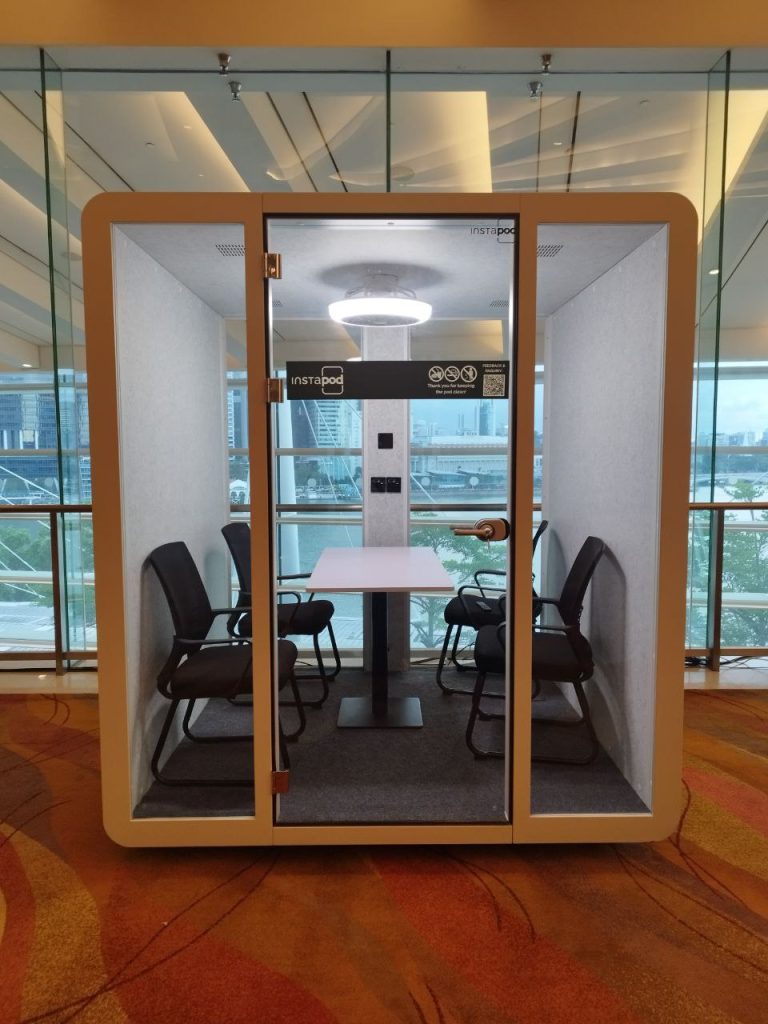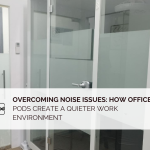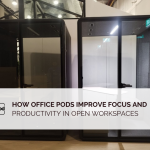No pods added to your quote request yet. Add some now for a free quote!
Office Pods: An Investment in Employee Happiness

In today’s fast-paced work environment, the need for focused and productive workspaces has become more pressing than ever. As open-plan offices have gained popularity for their collaborative benefits, they’ve also revealed a significant downside: the challenge of maintaining concentration amidst constant noise and interruptions. Enter office pods—compact, self-contained workspaces that are revolutionizing the way companies think about office design. More than just a trendy addition to the modern workplace, office pods are a smart investment in employee happiness, productivity, and overall well-being.
The Rise of Office Pods
Office pods, also known as work pods or focus booths, are enclosed spaces designed to provide employees with a quiet, private area to concentrate on tasks, take calls, or simply recharge away from the bustling office environment. These pods come in various sizes and designs, ranging from single-occupant booths to larger pods that can accommodate small teams for meetings or brainstorming sessions.
The growing popularity of office pods can be attributed to the increasing awareness of the impact of the work environment on employee performance and satisfaction. Open-plan offices, once hailed as the epitome of modern workplace design, have been shown to have drawbacks, particularly in terms of noise levels and lack of privacy. According to a study published in the Journal of Environmental Psychology, open-plan offices can lead to increased stress, reduced job satisfaction, and lower productivity due to the high levels of noise and distractions. Office pods offer a practical solution to these issues by providing employees with the option to retreat to a quiet space when needed.
Boosting Productivity and Focus
One of the primary benefits of office pods is their ability to enhance productivity. In a noisy, open-plan office, it can be challenging for employees to focus on tasks that require deep concentration. The constant hum of conversations, ringing phones, and the general hustle and bustle can make it difficult to stay on task. Office pods provide a soundproof environment where employees can work without distractions, leading to improved focus and efficiency.
Furthermore, office pods offer a flexible workspace that can be used for a variety of purposes. Whether an employee needs to concentrate on a complex project, take a confidential call, or participate in a virtual meeting, the pod provides a versatile solution. This flexibility not only supports individual productivity but also fosters a more agile and responsive work environment.
Enhancing Employee Well-Being
Employee well-being is increasingly recognized as a key factor in overall business success. Companies that prioritize the health and happiness of their employees tend to have higher levels of engagement, lower turnover rates, and better overall performance. Office pods contribute to employee well-being in several ways.
First, they offer a private space where employees can take a break from the demands of the office. In a high-stress work environment, having a quiet place to recharge can make a significant difference in an employee’s mental health. Whether it’s taking a few minutes to meditate, practice mindfulness, or simply sit in silence, the ability to step away from the noise can help reduce stress levels and improve overall well-being.
Additionally, office pods support a better work-life balance. With the rise of remote work and flexible working arrangements, employees are often juggling multiple responsibilities. Having a dedicated space where they can focus on work without distractions allows them to complete tasks more efficiently, freeing up time for other activities and reducing the likelihood of burnout.
Supporting Collaboration and Innovation
While office pods are primarily designed for focused work, they also play a role in supporting collaboration and innovation. Many companies are incorporating larger pods into their office layouts to create spaces where small teams can gather for brainstorming sessions, meetings, or collaborative work. These pods provide a more intimate and comfortable setting than traditional meeting rooms, which can foster more open communication and creative thinking.
Moreover, office pods can be equipped with technology that supports virtual collaboration, making them ideal for hybrid teams. With video conferencing capabilities, interactive whiteboards, and other collaborative tools, these pods can serve as hubs for innovation, enabling teams to work together seamlessly, whether they’re in the office or working remotely.
The Financial Investment
While the upfront cost of office pods may seem significant, the return on investment can be substantial. By enhancing productivity, improving employee well-being, and supporting collaboration, office pods can contribute to a more efficient and engaged workforce. This, in turn, can lead to higher levels of employee retention, reduced absenteeism, and ultimately, better business outcomes.
Furthermore, office pods can help companies optimize their office space. As the demand for flexible work arrangements continues to grow, businesses are rethinking their real estate needs. Office pods allow companies to create versatile workspaces within a smaller footprint, potentially reducing the need for extensive office space and lowering overall costs.
Conclusion
In the evolving landscape of modern work, office pods represent a smart investment in employee happiness and productivity. By providing a quiet, private space for focused work, they address the challenges of open-plan offices while supporting employee well-being and collaboration. As companies continue to adapt to new ways of working, office pods are likely to play an increasingly important role in creating work environments that foster both individual and collective success. Investing in office pods is not just about keeping up with workplace trends; it’s about prioritizing the needs and happiness of employees, which is ultimately a key driver of long-term business success.
Check these out too!
-
 The Role of Meeting Pods in Agile Work Environments: Flexibility and AdaptabilitySeptember 26, 2024/0 Comments
The Role of Meeting Pods in Agile Work Environments: Flexibility and AdaptabilitySeptember 26, 2024/0 Comments -
 How Office Pods Improve Focus and Productivity in Open WorkspacesSeptember 16, 2024/
How Office Pods Improve Focus and Productivity in Open WorkspacesSeptember 16, 2024/ -


